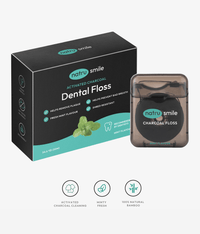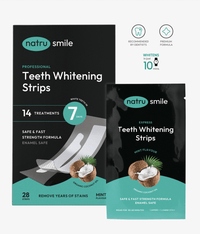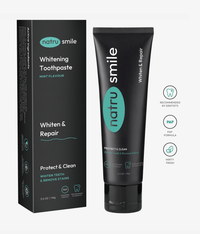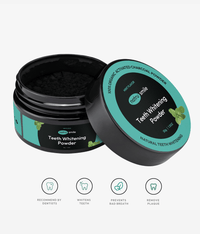
All products are certified by dental expert Dr. Greg Grillo
Of course, vaping is an unhealthy habit that can have serious implications for your respiratory and cardiovascular health. Beyond that, vaping and oral health have a similarly detrimental relationship. The vapor produced by e-cigarettes contains nicotine and other substances that can irritate the oral cavity, leading to a higher risk of periodontal disease, irritation, and tooth decay.
But we're going to be realistic. Around one in every 20 Americans uses vapes, making safety considerations for other activities a necessity.
So, can you vape after getting a tooth removed? In this guide, we'll explore the answer to this question and provide helpful advice about when you can resume your daily habits.
Is It Safe To Vape After Tooth Extraction?
Oral surgery puts a tremendous amount of strain on your whole body. Cutting into gum tissue and removing a tooth can cause inflammation, pain, and swelling in the area where the tooth was removed.
With a new wound in such a high-risk area, your body will also be working overtime to ward off any potential infections. And as your body manages the pain, your immune system and other bodily functions are weakened, making it more difficult for your body to heal.
In the same way smoking after a tooth extraction is strongly discouraged, vaping is, too.
Why You Shouldn't Vape After A Tooth Extraction
Vaping is a potentially dangerous activity with many harmful side effects in both the short term and long term. When it comes to post-operative oral health management, vape pens can be detrimental for several reasons.
- The sucking motion that comes with vaping can cause dry sockets. After a tooth extraction, blood clots form in the empty socket to protect the exposed tissue and start the healing process. Vaping after tooth extraction can disrupt this clotting process, creating what is known as a dry socket and causing severe pain.
- The nicotine in vape liquid slows down the healing process. Nicotine is a vasoconstrictor, meaning it constricts blood vessels, cutting off the blood flow to the area around your tooth extraction site. Without adequate blood flow and oxygen, the wound will take longer to heal and you may experience an increased risk of infection.
- High levels of nicotine reduce the amount of oxygen in your bloodstream. With limited oxygen in your circulatory system, you may feel lightheaded and nauseated. This can lead to dizziness, which can be dangerous for someone who has just had surgery.
- The heat from a vape pen can damage the gums and surrounding tissue. The warmth of a vape pen's vapor is often hot enough to irritate the sensitive gum tissue, making it more susceptible to infection.
- Dirty vape pens can cause bacterial contamination. Most people don't clean their vape pen religiously. Between storage, use, and travel, dirt and bacteria can accumulate on a vape pen. If you use your vape after a tooth extraction, you could be introducing that contamination directly into your wound, creating an even bigger risk of infection.
If you vape after having a tooth removed, you risk getting an infection, exacerbating your pain, and slowing down the healing process—all of which can be avoided by simply not vaping after a tooth extraction.
How Long To Wait Before Vaping After Tooth Removal
If you absolutely need to vape in the days following your tooth extraction, you should still wait 48 hours before doing so. This will give your body time to heal and the blood clot in the socket time to set.
You should also make sure you're doing everything else possible to speed up your recovery process, such as taking any antibiotics prescribed by your dentist and using any medications they have recommended for pain management.
Even after 48 hours have passed, you should keep your vaping sessions to a minimum. Vaping too much can still disrupt the clotting process and can cause irritation in the area of your extraction wound.
A general rule of thumb: If you aren't eating solid food yet, do not vape under any circumstances.
Vaping After Tooth Removal With Gauze
You might think that applying gauze to your extraction site after vaping can protect it from the heat. However, gauze does very little to shield your gums from the heat released by a vape pen or other nicotine delivery device. Even if it reduces contact with the chemicals and limits the impact of the sucking motion, it doesn't provide adequate protection to justify vaping after tooth extraction.
That said, you should still use gauze to protect your extraction wound after eating and drinking for the first few days following your tooth extraction.
Preventing Dry Sockets While Vaping
Most people see vaping as an alternative to smoking cigarettes—it's a discreet, convenient way to deliver nicotine to the lungs without burning tobacco. Many vape users feel it is softer and easier on the mouth, throat, and lungs than cigarettes.
But when it comes to your healing extraction site, there are no such distinctions. In the same way smoking tobacco can cause a dry socket, vaping can too.
To prevent this from happening, most vape users employ the same prevention strategies that others do:
- Using salt water rinse: Use warm salt water after vape sessions to flush out any debris or bacteria that may have entered the wound.
- Avoiding suction: Avoid drawing too much suction when vaping directly after tooth extraction. This can create a vacuum-like effect and increase the chance of dry socket formation.
- Eating soft foods: Eating soft foods after a tooth extraction can help reduce the pressure on the extraction site and avoid any irritation caused by hard or crunchy food.
Regardless of your vaping habit, these are measures you should take to avoid your dry socket anyways.
How To Vape Once 72 Hours Have Passed
Once the first two or three days have passed, you can slowly begin to vape again. The key word here is "slowly"—you should start off with a few short puffs protected by gauze, and gradually work up to longer sessions.
Additionally, you should always make sure your vape pen or other device is kept clean and the mouthpiece is changed regularly. This will reduce any bacteria that could irritate the extraction site.
If your vaping device has adjustable wattage settings, you should keep them at their lowest levels until your extraction site has fully healed. This will reduce the amount of heat released into the area around your wound and prevent any further swelling or discomfort.
Vaping After Tooth Extraction: Final Thoughts
Vaping after tooth extraction is strongly advised against for several reasons. Not only can it disrupt the clotting process and increase your risk of forming a dry socket, but it can also lead to excessive irritation in the area around your wound.
That said, once you have passed the 48 or 72-hour mark, you can start to reintroduce vaping in short bursts with gauze protection. The most important thing is to ensure that any device you use is clean and the wattage settings are kept at their lowest levels.
Want to learn more? These are the questions our customers ask us the most.
Can I Vape 48 Hours After Tooth Extraction?
In most cases, you can start vaping again little by little after 48 hours. However, waiting an additional 24 hours before vaping is highly recommended and can reduce the risk of getting a dry socket during healing. After this time, additional measures like gauze protection are strongly encouraged, as dry sockets can still form.
When Can I Vape After Wisdom Tooth Extraction?
The same general rules apply to all kinds of tooth extractions: You should refrain from vaping for at least 48 hours after wisdom tooth extraction. After this time, you can gradually reintroduce vaping in short bursts with gauze protection and ensure that all devices used are clean and wattage settings are kept as low as possible.
Is Vaping Bad After Tooth Extraction?
You should never vape immediately following an oral surgery. Vaping too soon can disrupt the clotting process, leading to a dry socket, swelling and other issues. The heat from vaping can also irritate the wound and increase healing time. To be safe, you should wait at least 48 hours before trying to vape again.
After this time, make sure you use gauze protection and keep your wattage settings low.
By following these precautions, you can ensure that your extraction site heals quickly and safely without any additional complications. Good
Can I Vape After Tooth Extraction With Stitches?
Stitches make the situation better, but they don't change the fact that your mouth is still healing. This means that you will still need to wait at least two days to use your vape again, as the wound is still vulnerable and the heat produced by vaping can make the healing process more difficult.
What Happens If I Vape After Tooth Extraction?
There is no concrete answer that explains what happens if you vape after oral surgery, as it depends on how long after the extraction you vape and whether or not any precautions are taken. If you vape too soon, then you run a higher risk of getting a dry socket or other complications such as excessive swelling or irritation.
How Can Vaping After Wisdom Teeth Removal Cause Dry Sockets?
The heat from vaping can disrupt the clotting process and cause dry sockets to form. It is also possible that bacteria or dirt particles will make their way into the wound, which can delay the healing process and increase your risk of infection.










